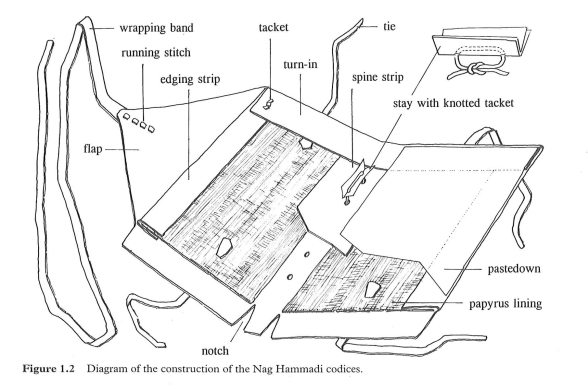As a follow-up to my last post on the development of the use of the French term “cartonnage”: It looks like it was the late 1950s when the term “cartonnage” began to be applied to the material sometimes used in ancient book covers. Today, this is a common usage among papyrologists. Some scholars of bookbinding have not been entirely happy with this development. So, for instance, in The Archaeology of Medieval Bookbinding (Ashgate, 1999), J.A. Szirmai notes that “the term ‘cartonnage’ – current with Egyptologists – seems to be inappropriate to differentiate between pasteboard or one or several layers of pastedowns” (p. 13, note 1). This point can be illustrated by looking at some examples. First off, the diagram of a generic Nag Hammadi codex in Szirmai’s book helps to understand all the terminology:

Image source: J.A. Szirmai, The Archaeology of Medieval Bookbinding (Ashgate, 1999), p. 8, Figure 1.2
It appears that in Szirmai’s usage, “pasteboard” refers to papyrus material inside covers (“papyrus lining” in the diagram), which is distinguished from “pastedowns,” which are glued down over the turn-ins (the folded edges of the leather cover). The distinction is useful because, in my experience, it is usually the inner material (“pasteboard”) that is inscribed, while “pastedowns” are more often blank. This phenomenon can be illustrated nicely by Nag Hammadi Codex VII. The process of taking apart this cover was partially documented with photographs, so that we can see the pastedowns and then, after their removal, the inscribed papyri below them:

Image source: The Facsimile Edition of the Nag Hammadi Codices: Codex VII (Brill, 1972), pp. 3-4
So, to bring the discussion back around to the original posting about Anton Fackelmann that prompted these reflections on the term “cartonnage”: When Fackelmann’s papyrus of the Acts of Paul and Thecla was described as coming from a “Buchdeckelfragment,” what is probably meant is “pasteboard” and not “pastedown,” as the Schøyen Collection website has it. But it is impossible to know for certain without having a more detailed report about the state of the cover before it was taken apart. This is why it is absolutely crucial that anytime a book cover composed of papyrus is taken apart, the whole process should be carefully documented (preferably with both photographs and written descriptions), both for the sake of the history of bookbinding (so that we can learn how the cover was constructed) and for the sake of more exact knowledge of the where in the cover each extracted papyrus came from. And it might not be a bad idea to reserve the term “cartonnage” to refer to mummy cartonnage and to use other descriptors for the papyrus that is sometimes used in book covers.


Pingback: The Atlantic Article and Green Collection Cartonnage | Variant Readings
Pingback: WORKING WITH COLLECTIONS – Embedding Conquest